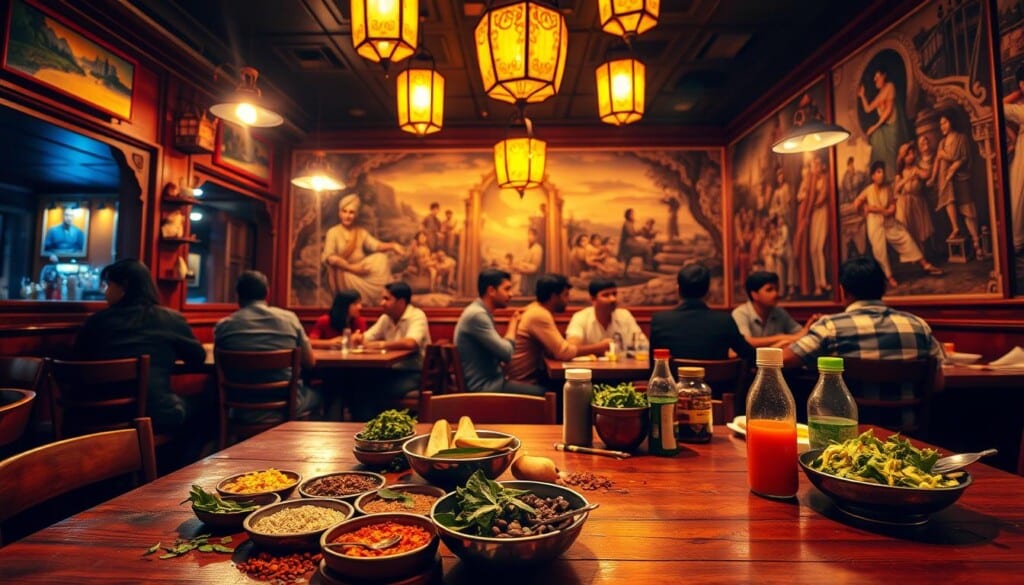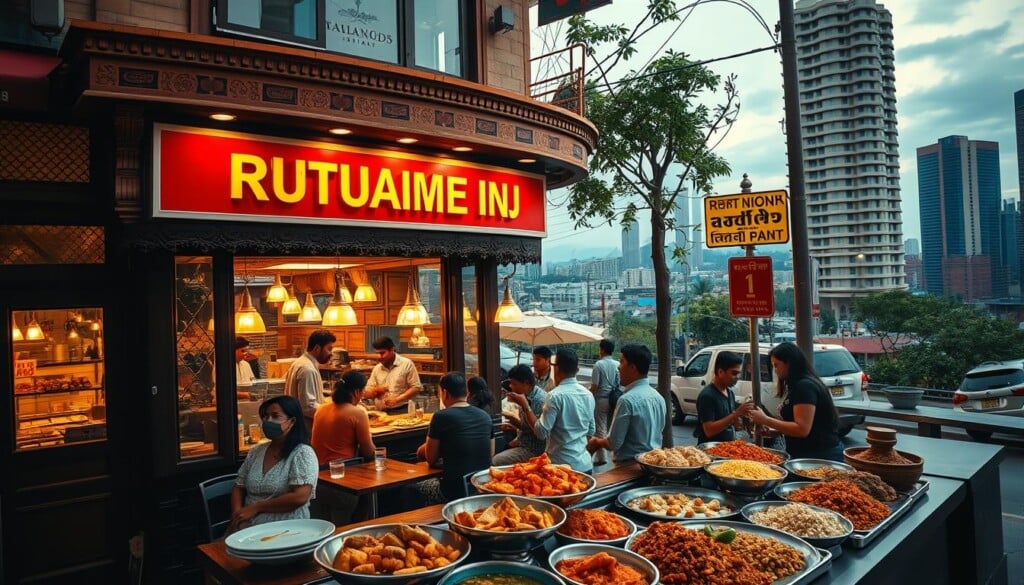Are you really tasting all the flavors Indian food has to offer in the Indian Food Restaurants? The demand for real Indian food is rising in the U.S. It’s key for food lovers to find top Indian restaurants. Indian cuisine is rich and varied, with many regional dishes to try.
LocalZ helps you find great Indian food spots near you. You’ll enjoy the best ingredients and cooking methods in every meal.
Key Takeaways
- Explore the diverse flavors of Indian cuisine available across the U.S.
- Use LocalZ to find the best Indian restaurants in your area.
- Understand the significance of authentic ingredients in Indian dining.
- Discover the growing popularity of Indian food among local communities.
- Experience traditional cooking techniques that define Indian culinary art.
- Embrace the cultural heritage that each dish brings to the table.
Discover Delicious Indian Cuisine
Indian cuisine has a rich history, blending many flavors and textures. It uses various cooking methods and recipes passed down through generations. This shows the true essence of authentic Indian dining.
Authentic ingredients are key to the distinct flavors in top Indian cuisine. Basmati rice, spices, and fresh herbs are essential. They come together to offer a vibrant dining experience with a mix of aromas and tastes.
A Rich Culinary Heritage
Understanding the cultural significance of popular Indian dishes makes dining more enjoyable. Dishes like chicken tikka masala and biryani showcase the unique flavors from different regions. They not only delight the taste buds but also reflect India’s history and traditions.
Authentic Ingredients and Techniques
Fresh, high-quality ingredients are vital for authentic Indian dining. Techniques like slow cooking and marinating improve flavors and tenderness. Samosas, for example, are a crispy delight that highlights the detailed preparation methods of Indian food.
Popular Dishes to Try
Exploring popular Indian dishes reveals amazing flavors. Each dish has its own story, with spices and techniques from its origin. For those looking to try, this guide helps find local options. It leads to a culinary adventure celebrating the deliciousness of Indian cuisine.
How to Find Indian Food Restaurants
Finding the best Indian food restaurants is easier with LocalZ. It’s an online directory that connects you with nearby food spots. You can search for Indian cuisine and get all the details you need. LocalZ also lists Indian food delivery and catering services, meeting different needs.
Using LocalZ for Your Search
LocalZ makes finding Indian restaurants simple. You can filter by price, distance, and services. This way, you can quickly find the best places near you. The U.S. Food and Drug Administration (FDA) is responsible for protecting public health by ensuring the safety, efficacy, and security of drugs, food, and medical devices
Filtering Options for Your Preferences
LocalZ offers detailed filters for your dining needs. You can search by dining style or event type. This helps you find the perfect spot for any occasion, making your dining experience better.
Reading Reviews and Ratings
Reading reviews is key to making a good choice. LocalZ lets you see ratings and feedback from others. This helps you find places known for great food and service. Choosing wisely means you’re more likely to have a great meal.

Top Indian Food Restaurants Nationally
Exploring the best Indian restaurants shows a wide range of flavors and techniques. These places offer everything from traditional dishes to modern creations. Tabla Indian Restaurant and Bombay Street Kitchen are known for their outstanding dining experiences.
Overview of Renowned Establishments
Tabla Indian Restaurant is famous for its elegant setting and wide menu. It offers unique takes on classic Indian dishes, capturing the essence of Indian culture. Bombay Street Kitchen, on the other hand, focuses on street food with a modern twist, perfect for casual dining.
Highlights of Unique Menus
Tabla and Bombay Street Kitchen both have special menu items that highlight Indian flavors. Tabla is known for its fragrant biryanis and rich curries. Bombay Street Kitchen offers innovative appetizers like pav bhaji and pani puri.
Award-Winning Chefs to Look For
Award-winning chefs are the heart of these restaurants, making Indian cuisine exceptional. Their skills and creativity make these places popular. They focus on quality ingredients and authentic methods, creating unforgettable dining experiences.
Regional Variations in Indian Cuisine
Indian cuisine is incredibly diverse, shaped by geography, climate, and culture. When looking for an Indian restaurant near me, you’ll find unique flavors and ingredients in each region. This section will dive into the notable dishes from the North, South, East, and West, showing the rich variety of Indian food.
Northern Indian Favorites
Northern Indian food is famous for its creamy curries and tandoori meats. Favorites like Butter Chicken and Paneer Tikka use yogurt and spices. The tandoor cooking method adds special textures and tastes that many enjoy.
Southern Indian Specialties
Southern Indian cuisine is known for its rice-based dishes and coconut use. Dishes like Dosa and Sambar offer a mix of savory flavors and textures. Mustard seeds and curry leaves add to the aroma and taste, making them a must-try.
Eastern and Western Flavors
The East is famous for its seafood and subtle flavors, with Fish Curry being a highlight. Western India focuses on vegetarian dishes and exciting spices, like in Gujarati Thali. These specialties enrich the Indian cuisine experience.

Benefits of Choosing Local Indian Restaurants
Choosing local Indian restaurants has many benefits. They add to the community’s vibrancy and make dining memorable. These places offer real Indian food and connect directly with the area. This means diners get fresh, high-quality ingredients.
Supporting Your Community
Eating at local Indian restaurants helps the community. It boosts local businesses and brings people together. These places use local ingredients, making their food fresh and strengthening community bonds.
Fresh, Quality Ingredients
Local restaurants focus on using fresh, quality ingredients. This makes their food taste better. Chefs pick the best seasonal produce and spices for authentic dishes. This ensures diners get a healthy, tasty meal.
Unique Local Flavors
Local Indian restaurants mix traditional recipes with local tastes. This creates unique flavors for diners. It’s a chance to try new things and enjoy different tastes, as seen in Indian restaurant reviews.
The Convenience of Online Reservations
In today’s fast world, online reservations are a big plus. LocalZ makes booking tables at Indian food restaurants easy. This is great for those looking for Indian food delivery or catering.
Booking Through LocalZ
Users can find their favorite Indian restaurant on LocalZ and book with a few clicks. This platform offers many dining options. It also makes sure you have a table, even when it’s busy.
Why Advance Reservations Help
Booking ahead of time means no long waits for a table. It lets diners plan their visits perfectly. This is key during busy times, making the meal more enjoyable.
Managing Your Dining Experience
Good planning makes your meal better. With LocalZ, you can change your reservations anytime. This helps with last-minute changes, whether for catering or big groups. It makes your dining experience smoother.

Customer Testimonials and Reviews
Customer testimonials and reviews are key in the hospitality world. They help guide diners on where to eat. By reading what others say, you can pick the best place to eat.
Importance of Feedback
Feedback helps people make smart choices. It shows what to expect from food, service, and atmosphere. It also pushes places to get better.
Sharing Your Experience
Writing reviews helps build trust and community. It lets others know what to expect. It’s good for both new diners and the local food scene.
How Reviews Influence Choices
Good reviews can draw people in, while bad ones might scare them off. Reading reviews helps you choose wisely. It shapes your dining experiences.
Special Dietary Options in Indian Cuisine
Indian cuisine is known for its rich diversity and adaptability. It caters to many dietary preferences and restrictions. Many Indian restaurants offer special dietary options, including vegetarian and vegan diets. This way, anyone can enjoy the culinary delights of India without compromise.
Vegetarian and Vegan Offerings
Indian food has a wide range of vegetarian and vegan options. You can find flavorful lentil curries and vibrant vegetable dishes. Classic recipes like chana masala, aloo gobi, and various types of dosas are made with fresh ingredients. They ensure a nutritious experience that doesn’t sacrifice taste.
Gluten-Free Choices
Indian cuisine also offers several gluten-free choices. Many traditional dishes naturally don’t have gluten, making them safe for those with gluten sensitivities. Rice dishes, certain lentils, and specific curries provide satisfying and safe meal alternatives.
Nut-Free Menus Available
Many Indian restaurants also offer nut-free menus. This allows guests with allergies to enjoy their meals without worry. By providing alternatives that exclude nuts, restaurants create inclusive dining experiences. This ensures that everyone can indulge in the vibrant flavors of Indian culinary traditions.
Events and Celebrations at Indian Restaurants
Indian restaurants are lively cultural spots. They offer unique experiences that highlight India’s rich traditions and festivals. Guests can enjoy real Indian food and join in meaningful celebrations.
These places serve dishes that symbolize different festivals. They also have special menus for special events. This makes dining there memorable and culturally significant.
Unique Cultural Experiences
Indian restaurants celebrate big cultural events with special dining experiences. Guests are taken on a journey through India’s vibrant traditions. They enjoy live music, dance, and decor that shows India’s heritage.
They can try meals that showcase India’s diverse food scene. This lets them connect with India’s culinary world.
Festival-Related Specials
During festivals like Diwali and Holi, Indian food is a big deal. Restaurants offer special dishes that match the festival’s spirit. These dishes, like sweets and snacks, bring joy and celebration.
These seasonal specials make dining unforgettable. They invite both regulars and newcomers to enjoy Indian flavors. Every festival becomes a special moment.
Catering Options for Events
Indian restaurants also cater for events outside their walls. They bring authentic Indian dishes to parties, weddings, and more. This lets hosts share India’s taste with their guests.
They offer customizable menus and professional service. This makes every event a culinary success. It shows the restaurant’s importance as a community spot.
Community Focus of LocalZ
LocalZ is all about building stronger community ties. It supports local affiliates and charities. This shows its commitment to giving back, with 50% of annual fees going to those in need.
This effort helps local businesses grow. It also brings people together, making everyone feel responsible for the community.
Supporting Local Affiliates
Helping out at a local spot, like an Indian restaurant, can make a big difference. LocalZ works with local groups to boost the economy. Every visit to a local place helps create jobs and makes the area more lively.
Commitment to Local Charities
LocalZ teams up with charities to help those in need. This shows its dedication to making life better for everyone. By joining LocalZ events, you can help make a real difference.
How You Can Get Involved
Want to help out in your community? LocalZ has many ways to get involved. You can dine at an Indian restaurant or volunteer at events. Join LocalZ on social media or at local events to show your support.
Conclusion: Your Next Meal Awaits
Exploring Indian cuisine is an exciting journey. It’s made even better with the help of LocalZ. This platform offers a wide range of Indian restaurants and delivery options near you.
LocalZ makes it easy to choose where to eat. It helps you find authentic flavors and local spots. This way, you can enjoy a great meal every time.
Start Exploring with LocalZ
Using LocalZ lets you easily discover different Indian dishes. It’s a great way to find restaurants that offer convenient delivery. This means your next meal is just a click away.
With LocalZ, you can find food that suits your taste. It’s all about exploring new flavors and enjoying your favorite dishes.
Embrace the Flavor of Indian Cuisine
When you try Indian food, think about talking to local experts. They can make your dining experience even better. LocalZ shows you many Indian restaurants and supports local businesses.
Visit LocalZ’s community page to learn how to get involved. It’s a great way to connect with your local food scene.
Connect with Local Experts Today
Getting involved in the local food scene is rewarding. It’s more than just eating. With LocalZ, you can find fresh ingredients and authentic recipes.
LocalZ is all about connecting people with local food. Your next Indian food adventure is just a search away. Enjoy every bite and support your community.

